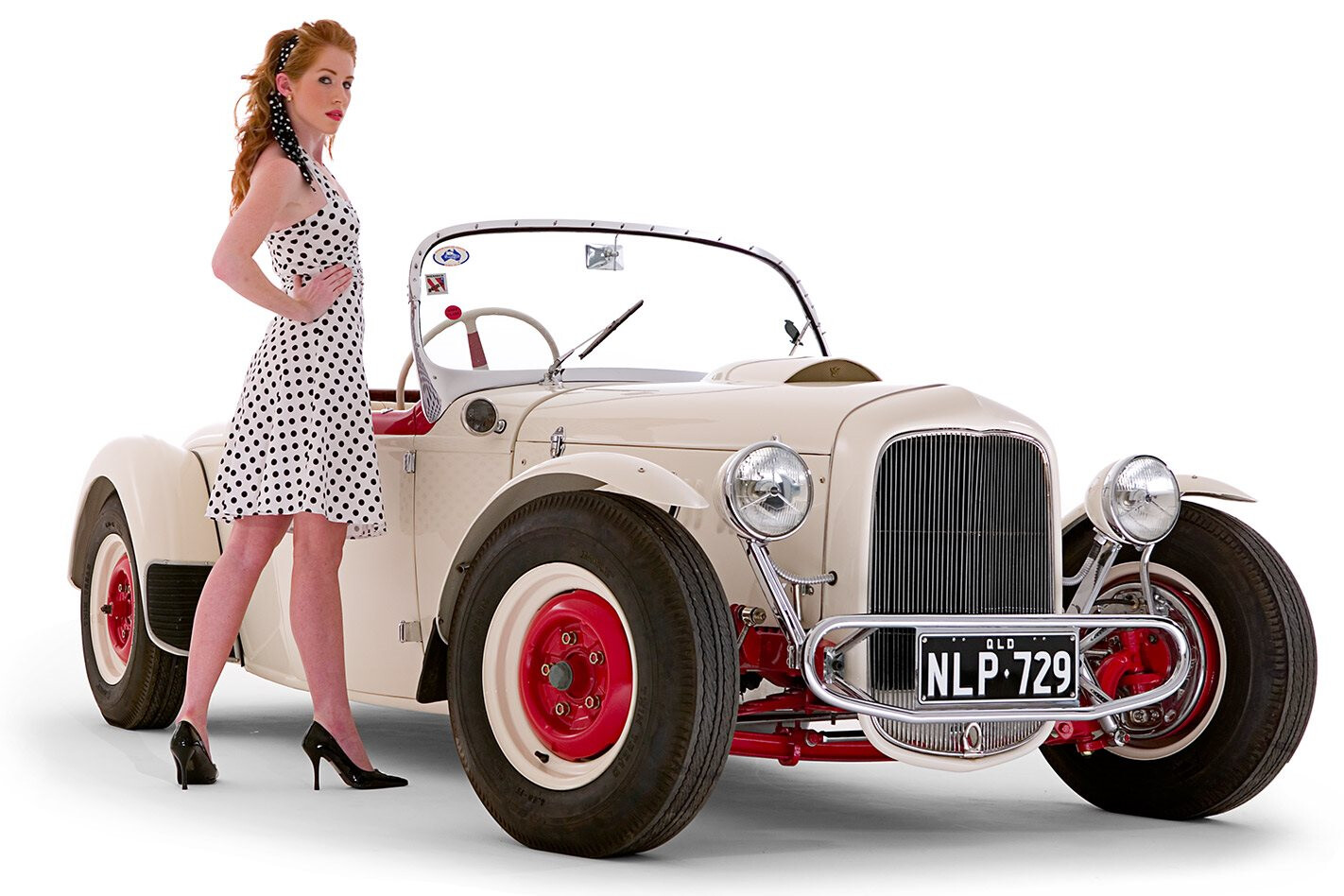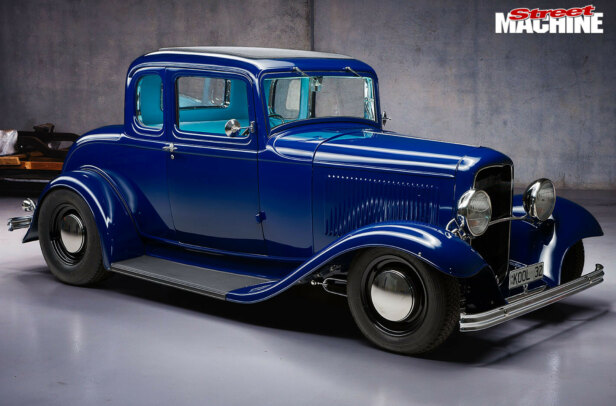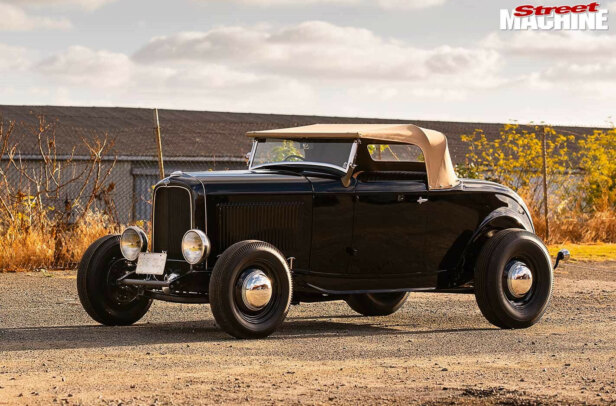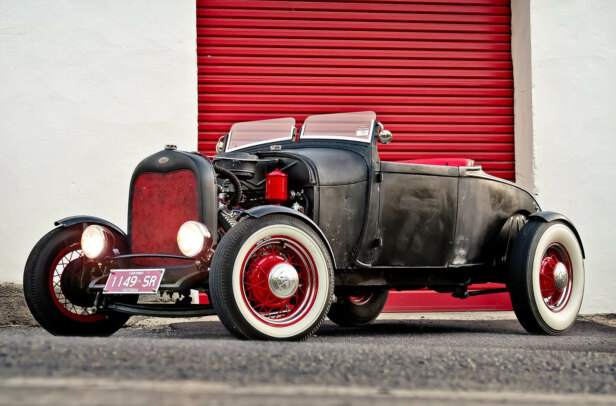This article on David Bowden’s roadster was originally published in Street Machine’s Hot Rod magazine, 2017
AUSSIE hot rodders were few and far between in the early 60s, and things we take for granted today — instant access to parts, information and money — were still a long way off. Although our cousins in the US had been going hammer and tongs since the end of WW2, racing their cars at every opportunity and on any surface they could find, in Australia hot rodding was still very much in its infancy.
For young Queenslander Rod Foote, those exploits across the sea were the stuff of dreams and from the first moment he laid his eyes on a copy of Hot Rod magazine he was hooked. More than 50 years later he’s still got the bug, although now he’s pushing 70 and has just undergone a hip replacement, so he’s content to watch other people enjoying their cars. But he was more than happy to have a chat about the car he built more than 45 years ago.
These days, Rod’s old roadster is part of the Bowden’s Own collection back in its native Queensland, and it’s looking better than ever: “I was gobsmacked when I first saw it; David has done a magnificent job,” says Rod.
For those of you who don’t know about David and his collection, check out www.bowdensown.com.au. What you’ll see are some of the most significant race cars to ever turn a wheel on Aussie soil. Which may make the old hot rod look a little out of place.
Rod’s roadster with fellow Shifter John Fleming’s ’33 outside the Gov. Bourke Hotel, Parramatta Rd, Camperdown
Not according to David: “I’ve always been a hot rodder and I watched this car getting built when I was a teenager. A mate of Rod’s was building a car at the same time and I ended up buying the project from him when he got married. Rod’s was like a show car but I was more interested in speed and had a supercharger on mine.”
Many years ago David found what was left of his old hot rod but sadly it would have been a bit of a grandfather’s axe rebuild as there wasn’t much of the original car left. It broke his heart to see it like that but all was not lost as David managed to track down Rod’s car, the original inspiration for his own.
Rod sold the car back in 1970: “It had been sitting under the shed and I had de-registered it. With a new family and business I couldn’t afford to run a work car and the hot rod. I let it go for £800 to a dealer, and I’m pretty sure he sold it the next day for a handy profit.”
The new owner was John Dowling, who thankfully looked after the car, and only made a couple of small changes to improve the steering. When John had an opportunity to work overseas, the car was up for sale once again. And that’s when David Bowden stepped in.
Steering wheel is a 1940 Ford Deluxe unit, while the eight-ball-equipped shifter operates a ’38 Ford box. Another advanced feature of the roadster is its swinging pedals, a modification that is still rare on rods today
“The car was in very good condition and had only done about 33,000 miles since Rod built it. She was a goer but the axle had been swapped and the motor was a bit secondhand. I wanted to restore it and I wanted it to be really good,” says David.
When David Bowden says ‘really good’, he’s not joking. It was taken straight down to Wolf Grodd and his team at Sleeping Beauties (www.sleepingbeauties.com.au). This is the crew that brought the Norm Beechey Monaro back from the dead, along with around 20 of David’s other cars. These guys work on very rare and desirable cars for customers from all over the world, the type of cars you see on the podium at the Pebble Beach Concours d’Elegance. Wolf works to a simple motto: “All it takes is time and money to restore a car, and we’ve got all the time in the world.”
Small scoop on hood is nicely detailed with more expanded mesh and a neat V8 badge
Wolf usually tackles Mercs, Porsches and Bentleys, so working on an old rod must have been quite a change.
“The car wasn’t all that bad, but rods of that era were never done to a high standard. Nothing really lined up, even when they were new. David planned to take the car to Pebble Beach and wanted it finished to that standard, yet still looking the way it did in the early 60s. The trick was to make it better but in such a way that no-one would notice it.”
It’s a real testament to the quality of Rod’s original work that the car stood up so well; the fact that he was an electrician by trade makes it even more admirable. Handily, Rod’s father was a diesel engineer and helped out quite a bit with the car, especially with the mechanical side of things and the chassis work.
Rod got the car sitting five inches lower in the rear by Z-ing the chassis, and then channelled the body over the frame by seven inches. With a four-inch dropped I-beam up front, the roadster really hugs the pavement. Channelling a roadster effectively narrows the silhouette of the car and can make the original grille shell look too tall. Rod not only sectioned it to match the proportions of the body but also filled the radiator filler cap and finished it with a neat peak.
More of Rod’s handiwork can be seen in the dashboard, where he created a stylish instrument cluster that houses a very desirable Stewart Warner speedo and tacho combination, as well as four smaller gauges that keep an eye on water temp, oil pressure, fuel level and amperage. The panel was detailed with a gold expanded-mesh backing, and to make sure the gauges could be read in the bright sunlight, a shroud protected them. That theme was carried over to the number plate, which is similarly shielded.
Flathead motor originally powered a ’48 Mercury but has been ported and relieved and fitted with some choice parts of the day. The intake and finned heads are Waggott. In fact Merv Waggott did a lot of the original engine work, including regrinding the cam. Rod says: “The motor was built to what we called three-quarter race specs. It was geared fairly high, for freeway cruising, but I took it down to Riverside Raceway once and it ran 17 seconds, which was pretty quick for the day.”
When it came to engine covers, most rodders were happy with flat sheet cut and rolled to match the curve of the cowl and grille but Rod wanted a more finished look. Although he was pretty handy on basic repairs, he knew he’d be better off getting an expert to do the trickier stuff, and found a panel shop that was more than capable of the quality of work he was looking for. Unfortunately, he can’t remember the name of the business but its work is still on the car for all to see.
Those rear fenders started off as ’36 Ford spare wheel covers — a popular choice for cycle fenders — but they’ve been extended on both sides to cover more of the tyre and to meet up neatly with the body. The same shop created the front fenders out of flat sheet and also made the engine cover and bonnet sides from scratch.
Four-inch-drop axle is a new addition but one that suits the car perfectly. Big drum brakes are ’48 Mercury
The louvres were punched by Rod, who recalls his father telling him: “If you use a very sharp cold chisel, you can cut the metal without any distortion.”
With the slits cut, Rod used a male and female die to press the shape of the louvre. Another neat — and identifiable — feature is the actual louvre pattern. Instead of simply punching the louvres evenly spaced in rows, Rod punched two rows of 12, grouped in lots of four. It’s a subtle touch but one that trainspotting hot rodders — and aren’t we all? — tend to notice.
Considering how much of the work listed so far was carried out by Rod, it’s no surprise that he also painted the car, selecting a couple of hues from the Holden colour charts. It was a brave choice but he went with a low-key India Ivory for the body, offset by the bright Carnation Red chassis and engine.
You won’t see a dash like this anywhere else. Original owner Rod Foote imported a Stewart Warner 160mph speedo and 6000rpm tacho from the US, added some locally sourced auxiliary gauges and housed them in a custom-built and shrouded panel. The expanded mesh adds a nice contrast and Rod even installed a radio — very rare for a hot rod back then!
As Rod planned to use the car regularly, some fairly hefty protection was required. When it featured in the March 1962 issue of Sports Car World, the author couldn’t have explained it more precisely: “To protect the car from drivers who park by ear, robust nerf bars are fitted front and rear, being constructed from one-inch-diameter tubing with quarter-inch-thick walls — even more sturdy than Sydney taxi bumpers!”
Although this story has focused on the original builder, if it weren’t for the passion and determination of David Bowden, the mechanical skills of the team at Bowden’s Own, and the metal magic performed by Sleeping Beauties, this car may have been lost to time and all we would have would be a few old black-and-white photos and fading memories. Happily, we’ll be able to enjoy this fine old hot rod for a long time yet.
SCREEN STAR
WITHOUT a doubt, the car’s signature is its wild windscreen treatment. Where most people would be happy with chopping a few inches out of the height for a leaner and meaner look, doing that to a heavily channelled roadster can lead to a fairly useless wind deflector.
Rod wanted something that would protect him, offer good vision, and look good. He found the perfect shape in a most unusual place — the rear of a ’50 Ford.
To build the frame, Rod positioned the windscreen where he wanted it, then shaped the bottom and sides of the frame in plaster of Paris, using the stock mounting locations and shaping a smooth surround that sealed against the cowl and curved with the shape of the glass.
With the glass removed, Rod then had to make allowance for a rubber seal. Once it was all smoothed out and the shape was just right, a mould was created and the frame was cast in brass. The top part of the frame was made using brass angle and flat strap to create a channel.
Rod thought about doing it in aluminium, but was warned that the casting process was a bit trickier. The brass has stood the test of time though; that’s the original frame that’s still on the car.
IN THE BEGINNING:
1. Wouldn’t you just love to find a ’32 roadster like this? Rod searched for a while and eventually found this relatively unmolested four-cylinder model. He didn’t bother trying to find a V8 as he had no plans of running the ’32 Flathead and the chassis was the same anyway.
2. Now it’s starting to look like something. The channel is complete and the grille has been smoothed out but not yet sectioned and the frame horns are still in place. It’s kinda cool with the wires as well, but they were soon to be replaced by more modern 16-inch units.
3. As you can see, the motor and chassis were beautifully detailed for the day. There have been some slight changes over the years including the relocation of the steering box, while the custom-built mechanical fan set-up went missing. The rebuilt engine has also copped a coat of red paint — obviously to make it go faster!
4. After moving to Sydney from Queensland, Rod started working at the Belmore Auto Centre. It was home to many of the top speedway midget racers of the day and Rod would have loved to get into the racing but the wife said otherwise! Parked next to Rod’s roadster is workmate Bernie Forner’s Chevy convertible. What a sight they must have been for passing traffic!
5. Rod gives journo Mike McCarthy the lowdown on the ’32 for the March 1962 issue of Sports Car World. Hot rods were a rarity on Australian roads in those days but Mike was taken with Rod’s creation: “We can honestly say we were most impressed with its appearance, finish and performance.”
DAVID BOWDEN
1932 FORD ROADSTER
Colour: Holden Indian Ivory & Carnation Red
ENGINE
Brand: Mercury 1948 sidevalve, 239ci
Built by: Kevin Bartlett and Clive Noonan
Induction: Twin Stromberg 97s on Waggott intake
Heads: Waggott finned alloy
Camshaft: Waggott three-quarter race
Exhaust: Dual headers and pipes
TRANSMISSION
Gearbox: Ford 1938
Diff: Mercury 1948
Clutch: Ford truck
SUSPENSION & BRAKES
Springs: Ford 1948 transverse (f), Ford 1932 transverse (r)
Shocks: Armstrong tubular (f&r)
Mods: Chassis Z’d five inches (r), four-bar front suspension, four-inch dropped I-beam
Steering: HR Holden
Brakes: Mercury 1948
PAINT & BODY
Sprayed by: Sleeping Beauties
Panel work by: Sleeping Beauties
Body mods: Channelled seven inches, custom windscreen frame, sectioned grille
INTERIOR
Seats: Custom
Wheel: Ford Deluxe 1940
Trim: Vynex
Instruments: Stewart Warner speedo and tacho with auxiliary gauges
Carpet: Red with white trim
Stereo: AM radio
Speaker: Under dash
WHEELS & TYRES
Wheels: Mercury 16-inch
Tyres: Tall and skinny




Comments